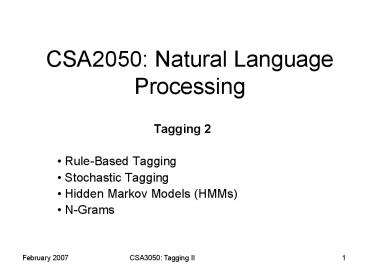CSA2050: Natural Language Processing - PowerPoint PPT Presentation
Title:
CSA2050: Natural Language Processing
Description:
if word 1 is an adj, adv, or quantifier and the following ... 1 A/ADV/QUANT) ( 2 SENT-LIM) (NOT -1 SVOC/A) Then eliminate non-ADV tags. Else eliminate ADV tag ... – PowerPoint PPT presentation
Number of Views:52
Avg rating:3.0/5.0
Title: CSA2050: Natural Language Processing
1
CSA2050 Natural Language Processing
- Tagging 2
- Rule-Based Tagging
- Stochastic Tagging
- Hidden Markov Models (HMMs)
- N-Grams
2
Tagging 2 Lecture
- Slides based on Mike Rosner and Marti Hearst
notes - Additions from NLTK tutorials
3
Rule-Based Tagger
- Basic Idea
- Assign all possible tags to words
- Remove tags according to set of rulesif word1
is an adj, adv, or quantifier and the following
is a sentence boundary and word-1 is not a verb
like consider then eliminate non-adv else
eliminate adv. - Typically more than 1000 hand-written rules, but
may be machine-learned.
4
ENGTWOL
- Based on two-level morphology
- 56,000 entries for English word stems
- Each entry annotated with morphological and
syntactic features
5
Sample ENGTWOL Lexicon
6
ENGTWOL Tagger
- Stage 1 Run words through morphological analyzer
to get all parts of speech. - E.g. for the phrase the tables, we get the
following output"ltthegt" "the" ltDefgt DET
CENTRAL ART SG/PL "lttablesgt" "table" N NOM PL
"table" ltSVOgt V PRES SG3 VFIN - Stage 2 Apply constraints to rule out incorrect
POSs
7
Examples of Constraints
- Discard all verb readings if to the left there is
an unambiguous determiner, and between that
determiner and the ambiguous word itself, there
are no nominals (nouns, abbreviations etc.). - Discard all finite verb readings if the
immediately preceding word is to. - Discard all subjunctive readings if to the left,
there are no instances of the subordinating
conjunction that or lest. - The first constraint would discard the verb
reading in the previous representation. - There are about 1,100 constraints
8
Example
- Pavlov PVLOV N NOM SG PROPER
- had HAVE V PAST VFIN SVO
- HAVE PCP2 SVO
- shown SHOW PCP2 SVOO SVO SV
- that ADV
- PRON DEM SG
- DET CENTRAL SEM SG
- CS
- salivation N NOM SG
9
Actual Constraint Syntax
- Given input thatIf (1 A/ADV/QUANT) (2
SENT-LIM) (NOT -1 SVOC/A)Then eliminate non-ADV
tagsElse eliminate ADV tag - this rule eliminates the adverbial sense of that
as in it isnt that odd
10
3 Approaches to Tagging
- Rule-Based Tagger ENGTWOL Tagger(Voutilainen
1995) - Stochastic Tagger HMM-based Tagger
- Transformation-Based Tagger Brill Tagger(Brill
1995)
11
Stochastic Tagging
- Based on the probability of a certain tag given
various possibilities. - Necessitates a training corpus.
- Difficulties
- There are no probabilities for words that are not
in the training corpus. ? Smoothing - Training corpus may be too different from test
corpus.
12
Stochastic Tagging
- Simple Method Choose the most frequent tag in
the training text for each word! - Result 90 accuracy !!
- But we can do better than that by employing a
more elaborate statistical model - Hidden Markov Models (HMM) are a class of such
models.
13
Hidden Markov Model(for pronunciation)
start ax b aw end start ix b aw dx end start
ax b ae t end
Observation Sequences
14
Three Fundamental Questions for HMMs
- Given an HMM, how likely is a given observation
sequence? - Given an observation sequence, how do we choose a
state sequence that best explains the
observations? - Given an observation sequence and a space of
possible HMMs, how do we find the HMM that best
fits the observed data?
15
Two Observation Sequences for Tagging
16
Two Kinds of Probability involved in generating a
sequence
- t1 t2 t3 t5 t6
- w1 w2 w3 w4 w5 Transitional
- t1 t2 t4 t5 t6 P(tagprevious n
tags) - t1 t2 t3 t5 t6
- w1 w2 w3 w4 w5 Output
- t1 t2 t4 t5 t6 P(wt)
17
Simplifying Assumptions cannot handle all
phenomena
- Limited Horizon a given tag depends only upon a
N previous tags usually N2. - central embedding?The cat the dog the bird saw
bark meowed. - long distance dependenciesIt is easy to consider
it impossible for anyone but a genius to try to
talk to Chris. - Time (sentence position) invariance (P,V) may
not be equally likely at beginning/end of sentence
18
Estimating N-gram probabilities
- To estimate the probability that Z appears
after XY - count how many times XYZ appears A
- count how many times XY appears B
- Estimate A/B
- Same principle applies for tags
- We can use these estimates to rank alternative
tags for a given word.
19
Data Used for Training a Hidden Markov Model
- Estimate the probabilities from relative
frequencies. - Transitional probabilities probability that a
sequence of tags t1, ... tn is followed by a tag
t - P(tt1..tn) count(t1..tnfollowed by
t)/count(t1..tn) - Output probabilities probability that a given
tag t will be realised as a word w P(wt)
count(w tagged as t)/count(t)
20
An Example
- Secretariat/NNP is/VBZ expected/VBN to/TO
race/VB tomorrow/NN - People/NNS continue/VBP to/TO inquire/VB the DT
reason/NN for/IN the/DT race/NN for/IN outer/JJ
space/NN - Consider first sentence choose between
- A to/TO race/VBB to/TO race/NN
- We need to choose maximum probability
- P(A) P(VBTO) P(raceVB)
- P(B) P(NNTO) P(raceNN)
21
Calculating Maximum
22
Remarks
- We have shown how to calculate the most probable
tag for one word. - Normally we are interested in the most probable
sequence of tags for the entire sentence. - The Viterbi algorithm is used to calculate the
entire sentence probability - Have a look at
- http//en.wikipedia.org/wiki/Viterbi_algorithm
- For a quick introduction (PDF on website)
23
Next Sessions
- Transformation Based Tagging
- Chunking































